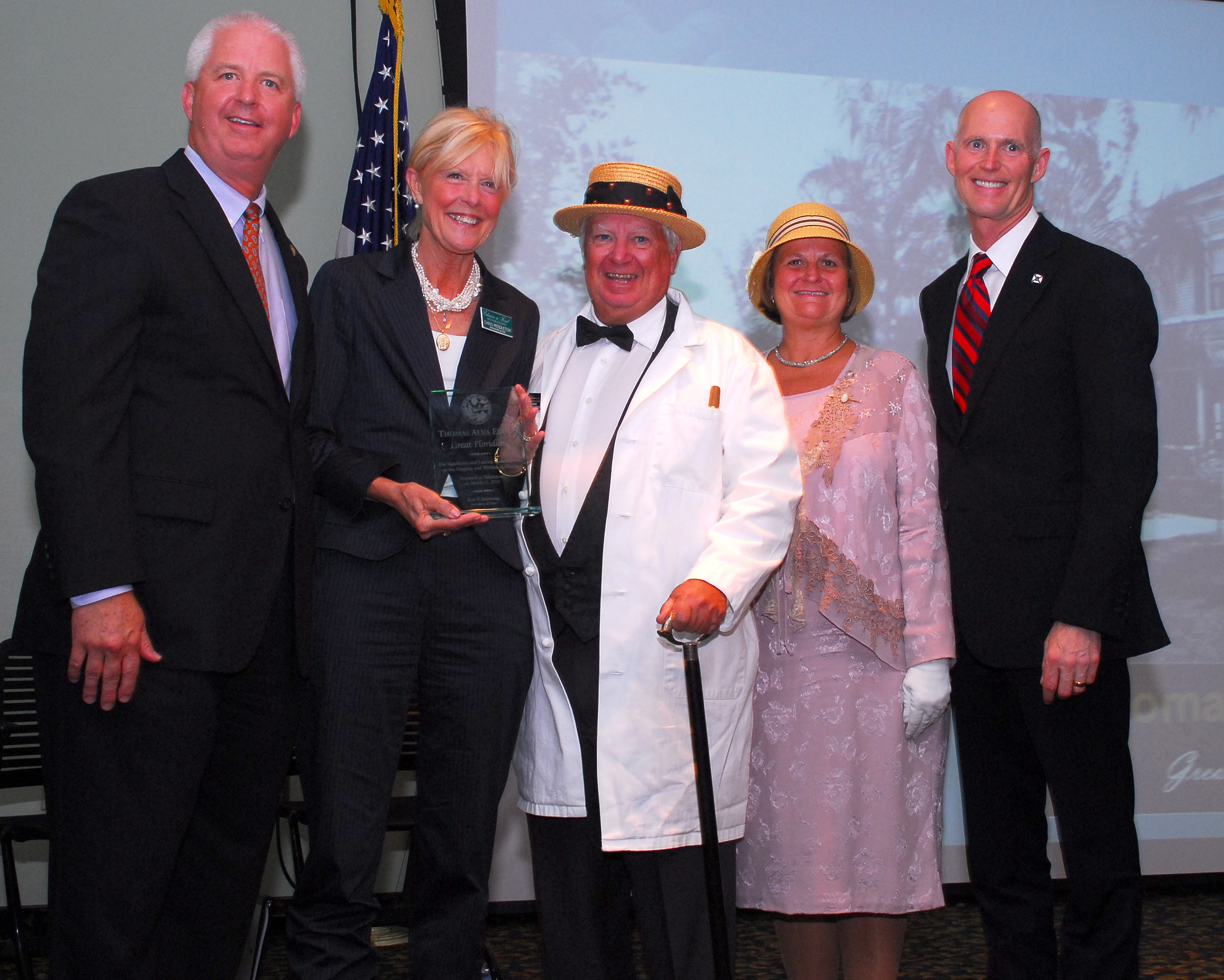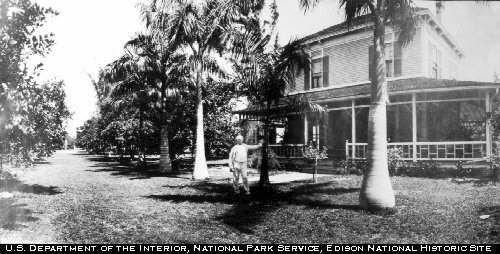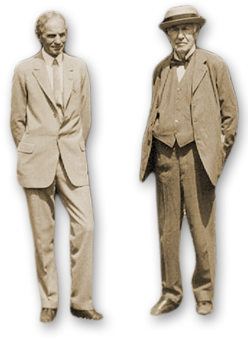Thomas Edison receives 2011 Great Floridian Award from State of Florida
March 30, 2011
 Thomas Alva Edison, posthumously received the 2011 Great Floridian Award from Governor Rick Scott and Secretary of State Kurt S. Browning at the Florida Heritage Awards Ceremony in Tallahassee. Edison and his family wintered in Fort Myers from 1885 until 1947 when his widow, Mina Edison deeded the Estate to the City of Fort Myers to be opened to the public.
Thomas Alva Edison, posthumously received the 2011 Great Floridian Award from Governor Rick Scott and Secretary of State Kurt S. Browning at the Florida Heritage Awards Ceremony in Tallahassee. Edison and his family wintered in Fort Myers from 1885 until 1947 when his widow, Mina Edison deeded the Estate to the City of Fort Myers to be opened to the public.
Historic reenactors, Thomas and Mina Edison joined Edison and Ford Winter Estates president & CEO, Chris Pendleton in Tallahassee to receive the award. The award is on display in the Edison and Ford Winter Estates Museum.
“Edison accomplishments as a great Floridian helped shape Florida’s history and the Estates continues to honor his legacy through the preservation of his home and programs in history, science and the arts,” said Pendleton.
The list of Edison accomplishments cited at the 2011 Great Floridian Awards ceremony included:
 Thomas Alva Edison traversed the State of Florida in 1885 and eventually discovered a small cattle town called Fort Myers. By 1886, he created a winter home and research laboratory complex and came to Florida regularly until his death in 1931. His prominence, interest and involvement helped propel the young State of Florida into national fame. One of his most famous quotes was based on the population of the young nation at the time as well as its love of travel, ‘there is only one Fort Myers in the United States, and there are 90 million people who are going to find it out.’ The quote has proven true as Edison’s winter estate is one of the top ten most visited historic home sites in America. Edison loved Florida for its natural beauty, abundant resources, emerging industries, temperate weather, fishing and camping opportunities and its people (named his estate Seminole Lodge).Until the railroad was connected in 1904, Edison traveled to Fort Myers by boat. In 1931, he commemorated the new Edison Bridge on the recently opened Tamiami Trail connecting Tampa to Miami through Fort Myers. Between 1914 and 1924, Edison and his colleague Henry Ford set out on a series of famous camping trips throughout America. The camping trips began with their Everglades camping expedition of 1914 which achieved national press. In 1917, as head of the US Navy Consulting Board, Edison was stationed in Key West to conduct research useful to the war effort. One of his experiments involved a listening device designed to detect enemy ships underwater. Edison used his winter estate to entertain his guests and family but also to cultivate some of Florida’s best known tropical plants, including, citrus, mangos, palms, orchids, bamboo (for his light bulb filament) and 17,000 varieties of rubber plants and trees. Edison’s good friend and colleague, Henry Ford, bought the estate next to Edison in 1916 which connected Florida to the automobile industry and the American craze for motorized travel. The Edison years in Florida were marked by notable visits from friends and colleagues like Henry Ford, Harvey Firestone and John Burroughs, the famous American naturalist, author and poet. Edison was also visited from Herbert Hoover shortly before being inaugurated as the 31st President of the United States in 1929. In July of 1927, Edison, Ford and Firestone formed the Edison Botanic Research Corporation and established a major chemistry laboratory in Fort Myers. The famous trio were committed to finding an organic source of rubber which could be grown in this country and processed for the nation’s needs for automobile tires, factory equipment, battery parts and other important items. Edison believed this rubber would be especially useful in wartime when embargoes were inevitable and international sources of rubber would be costly. Construction on Edison’s Botanic Research Laboratory in Fort Myers was completed by June of 1928 and was surrounded by research beds for growing and testing thousands of rubber producing plants. The Edison Botanic Research Laboratory in Fort Myers is the only one of its kind in its original location in the nation. It includes the original equipment for its function as a chemistry lab, machine shop, darkroom and general purpose scientific station for the Edison Botanic Research Corporation. Edison’s plant research in Florida had another lasting impact on the nation’s history as it created a significant change in American patent law which had not included chemical or botanical discoveries in its patent protection process. Edison’s work resulted in a new legislation to create and protect the patent work of plant and chemical scientists. By 1931 Thomas Edison and his colleagues discovered that they could extract up to 9% rubber from the processes in this lab using various specimens of goldenrod, including Solidago leavenworthii and Solidago Edisonia and devised a distillation method known as the bromination test or bromine process. Edison died in 1931 leaving a legacy of 1093 patents, unsurpassed in American history, which includes a patent for almost every aspect of our lives from electricity, electrical devices, communications, plant science, music, movies and the film industry.In 1947 his widow, Mina Edison, deeded the Edison Winter Estate to the City of Fort Myers to be open to the public as a memorial to her husband and his work. In 2006, a new non-profit corporation assumed the governance and management of the Edison and Ford Winter Estates, Museum, Laboratory and Botanical Gardens. To date, the new corporation, Edison and Ford Winter Estates, Inc., has completed more than $13 million in restoration and improvements to the site, operates with a $4.5 million budget, 60 paid staff, 250 volunteers and has remained one of the top ten most visited historical home sites in the nation. The new corporation has also been awarded the 2009 top award from the National Trust for Historic Preservation and the 2010 top award from the National Garden Clubs Inc. Mr. Edison would be proud and happy.
Thomas Alva Edison traversed the State of Florida in 1885 and eventually discovered a small cattle town called Fort Myers. By 1886, he created a winter home and research laboratory complex and came to Florida regularly until his death in 1931. His prominence, interest and involvement helped propel the young State of Florida into national fame. One of his most famous quotes was based on the population of the young nation at the time as well as its love of travel, ‘there is only one Fort Myers in the United States, and there are 90 million people who are going to find it out.’ The quote has proven true as Edison’s winter estate is one of the top ten most visited historic home sites in America. Edison loved Florida for its natural beauty, abundant resources, emerging industries, temperate weather, fishing and camping opportunities and its people (named his estate Seminole Lodge).Until the railroad was connected in 1904, Edison traveled to Fort Myers by boat. In 1931, he commemorated the new Edison Bridge on the recently opened Tamiami Trail connecting Tampa to Miami through Fort Myers. Between 1914 and 1924, Edison and his colleague Henry Ford set out on a series of famous camping trips throughout America. The camping trips began with their Everglades camping expedition of 1914 which achieved national press. In 1917, as head of the US Navy Consulting Board, Edison was stationed in Key West to conduct research useful to the war effort. One of his experiments involved a listening device designed to detect enemy ships underwater. Edison used his winter estate to entertain his guests and family but also to cultivate some of Florida’s best known tropical plants, including, citrus, mangos, palms, orchids, bamboo (for his light bulb filament) and 17,000 varieties of rubber plants and trees. Edison’s good friend and colleague, Henry Ford, bought the estate next to Edison in 1916 which connected Florida to the automobile industry and the American craze for motorized travel. The Edison years in Florida were marked by notable visits from friends and colleagues like Henry Ford, Harvey Firestone and John Burroughs, the famous American naturalist, author and poet. Edison was also visited from Herbert Hoover shortly before being inaugurated as the 31st President of the United States in 1929. In July of 1927, Edison, Ford and Firestone formed the Edison Botanic Research Corporation and established a major chemistry laboratory in Fort Myers. The famous trio were committed to finding an organic source of rubber which could be grown in this country and processed for the nation’s needs for automobile tires, factory equipment, battery parts and other important items. Edison believed this rubber would be especially useful in wartime when embargoes were inevitable and international sources of rubber would be costly. Construction on Edison’s Botanic Research Laboratory in Fort Myers was completed by June of 1928 and was surrounded by research beds for growing and testing thousands of rubber producing plants. The Edison Botanic Research Laboratory in Fort Myers is the only one of its kind in its original location in the nation. It includes the original equipment for its function as a chemistry lab, machine shop, darkroom and general purpose scientific station for the Edison Botanic Research Corporation. Edison’s plant research in Florida had another lasting impact on the nation’s history as it created a significant change in American patent law which had not included chemical or botanical discoveries in its patent protection process. Edison’s work resulted in a new legislation to create and protect the patent work of plant and chemical scientists. By 1931 Thomas Edison and his colleagues discovered that they could extract up to 9% rubber from the processes in this lab using various specimens of goldenrod, including Solidago leavenworthii and Solidago Edisonia and devised a distillation method known as the bromination test or bromine process. Edison died in 1931 leaving a legacy of 1093 patents, unsurpassed in American history, which includes a patent for almost every aspect of our lives from electricity, electrical devices, communications, plant science, music, movies and the film industry.In 1947 his widow, Mina Edison, deeded the Edison Winter Estate to the City of Fort Myers to be open to the public as a memorial to her husband and his work. In 2006, a new non-profit corporation assumed the governance and management of the Edison and Ford Winter Estates, Museum, Laboratory and Botanical Gardens. To date, the new corporation, Edison and Ford Winter Estates, Inc., has completed more than $13 million in restoration and improvements to the site, operates with a $4.5 million budget, 60 paid staff, 250 volunteers and has remained one of the top ten most visited historical home sites in the nation. The new corporation has also been awarded the 2009 top award from the National Trust for Historic Preservation and the 2010 top award from the National Garden Clubs Inc. Mr. Edison would be proud and happy.

